Magento, a powerhouse in the e-commerce realm, has long been a trusted framework for businesses seeking to establish a robust digital presence. Indeed, Magento is one of the top 10 eCommerce platforms and processes more than $155 billion in transactions yearly. Although its functionality is extolled by millions, Magento’s backend still remains undiscovered for many. Yet, an understanding of the platform’s hierarchy can help users increase the convenience and efficiency of their Magento stores.
Magento provides four structural levels to increase flexibility and configurability, aiding businesses in addressing their requirements. These levels include global, website, store, and store view. A user can operate numerous sites and stores with one backend. Which level to choose and how to configure the backend properly?
To create an easy-to-understand step-by-step guide, we harnessed the expertise of a team of experienced eCommerce professionals:
- Pablo Poberezhnyi – an Adobe Certified Professional and Magento 2 developer with over 8 years of software development experience. Pablo crafted a user-friendly guide for eCommerce site owners on setting up a multistore.
- Aleksei Tarasov – a Certified Adobe Commerce (Magento) Expert with 7 years of experience as an eCommerce Project Manager. Aleksei provided valuable insights and practical advice for optimizing multistore setups.
- Webster Webmeridian – an eCommerce Expert & Business Development Manager with over 6 years of experience in business growth strategies. Webster has successfully spearheaded numerous projects to optimize online retail and significantly enhance sales.
- Kate Odyntsova – the Lead Project Manager with over 4 years of experience in eCommerce development, website customization, and problem-solving for online stores. Kate ensured the guide was comprehensive and easy to follow.
In this article, we will focus on Magento multi store vs. multi website strategies, aiming to help merchants navigate this complex terrain. By understanding the differences and aligning them with unique business requirements, companies can attain the optimal Magento setup to achieve their business goals.
We will explore the distinctive features of each strategy, analyze the differences between Magento multi-store and multi-website, and provide recommendations that can help companies form their eCommerce trajectory.
- Setup Magento Multi Store: Step by Step with Expert
- Magento Multi Store Development: Top 7 Questions and Answers from an Expert
- Understanding Magento Multi Store
- Exploring Magento Multi-Website
- Factors to Consider When Choosing Between Multi-Store and Multi-Website
- Top 3 Disadvantages of Magento Multi Store
- Best Practices and Implementation Tips
- Conclusion
Get A Magento Expert Consultation
Our Adobe Business Practitioner conducts site audit to optimize your eCommerce weaknesses.

Setup Magento Multi Store: Step by Step with Expert
Adobe Certified Professional, a Magento 2 developer with 8+ years of software development experience, created an easy step-by-step guide to setting up a Magento 2 multistore for eCommerce site owners. Our expert, Pablo Poberezhnyi, has worked on many projects, ranging from small parsers and SPA development to high loads with 10,000 clients daily. He has worked with e-banking, e-shops, and web-scrapers.
Setting up a Magento mult istore can seem daunting, but this guide will break down the process into simple, easy-to-follow steps. Let’s get started!
Step 1: Create Categories
- Open Your Magento Admin Panel.
- Create Categories for Each Store:
- Navigate to Catalog -> Categories.
- Create the root category for your new store.
- Set the name and URL key for each category.
Tip: You’ll need these categories later when you create your stores.
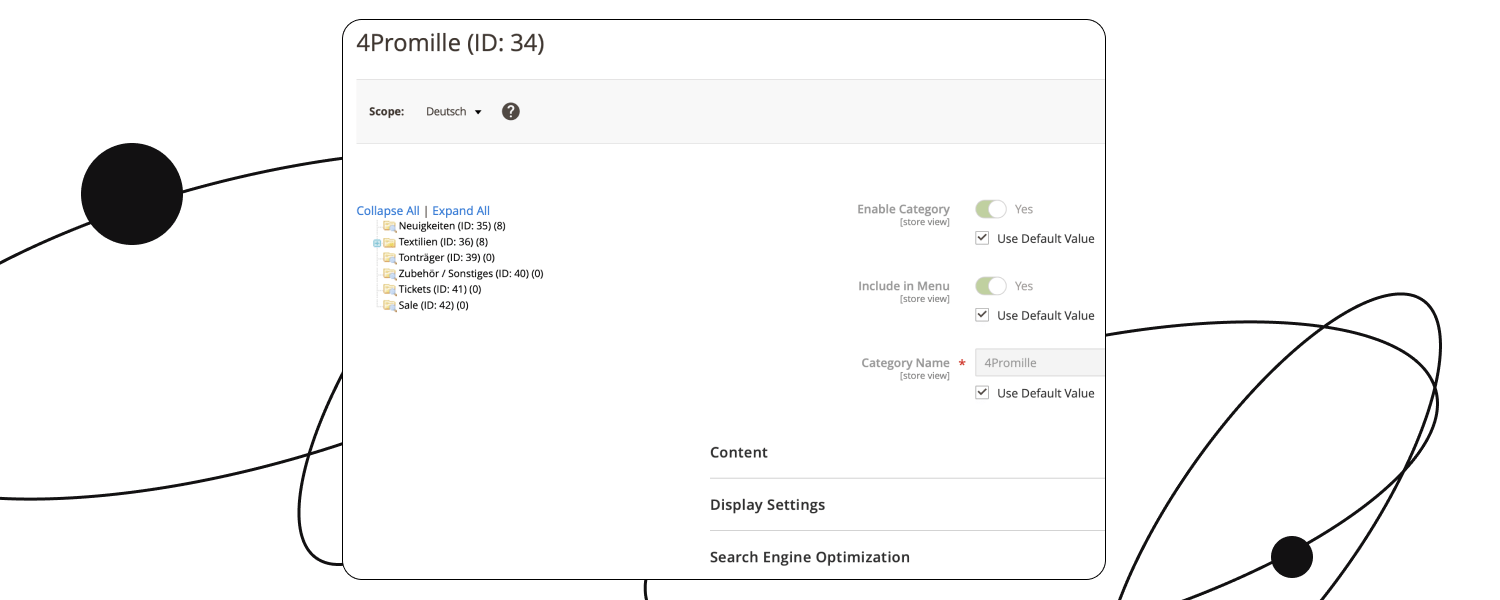
Step 2: Create Stores and Websites
- Navigate to Stores -> Settings -> All Stores.
- Create New Websites, Stores, and Store Views:
- Click on “Create Website” to add a new website.
- Click on “Create Store” to add a new store under the website.
- Click on “Create Store View” to add a store view under the store.
Tip: Each store view can have its own language and other custom settings.
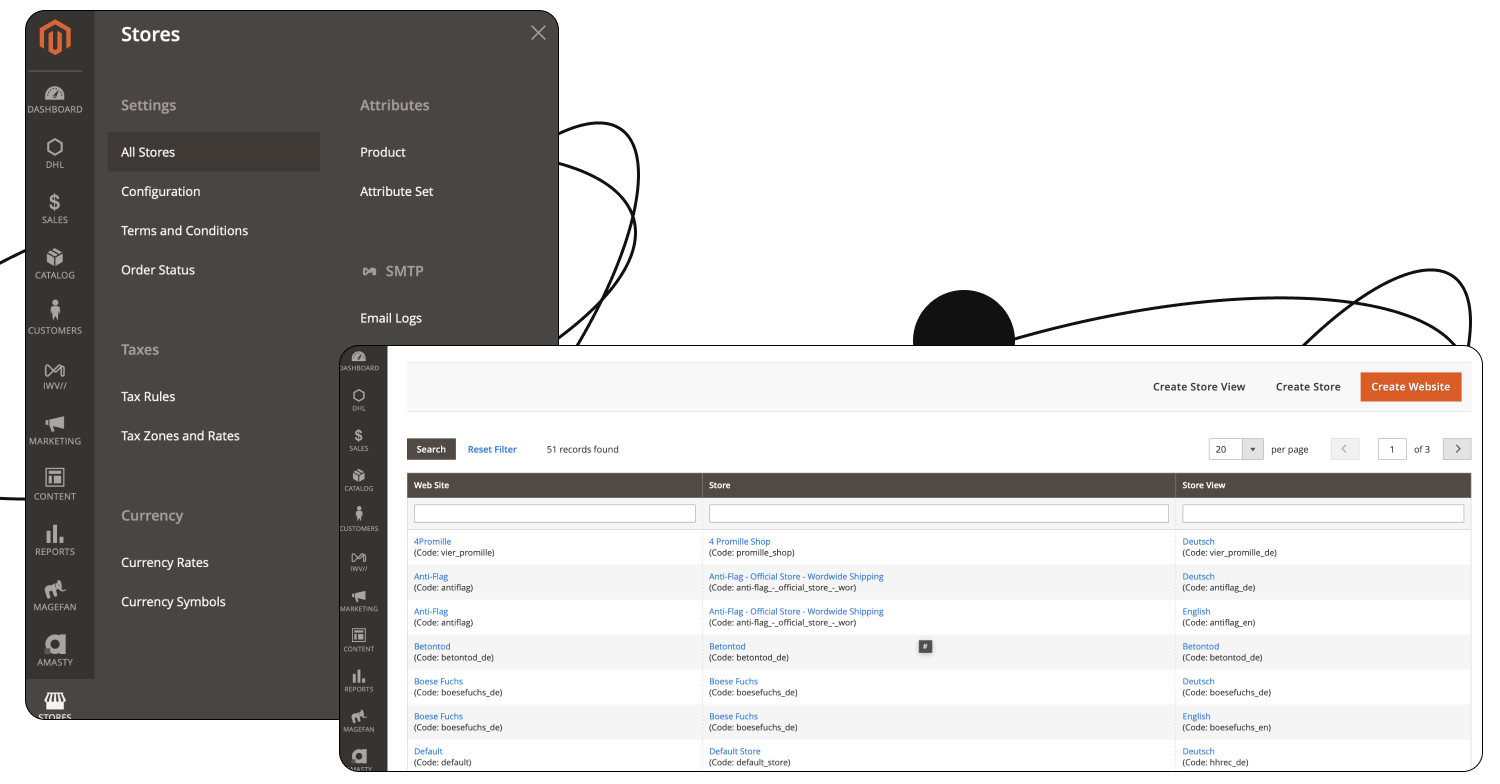
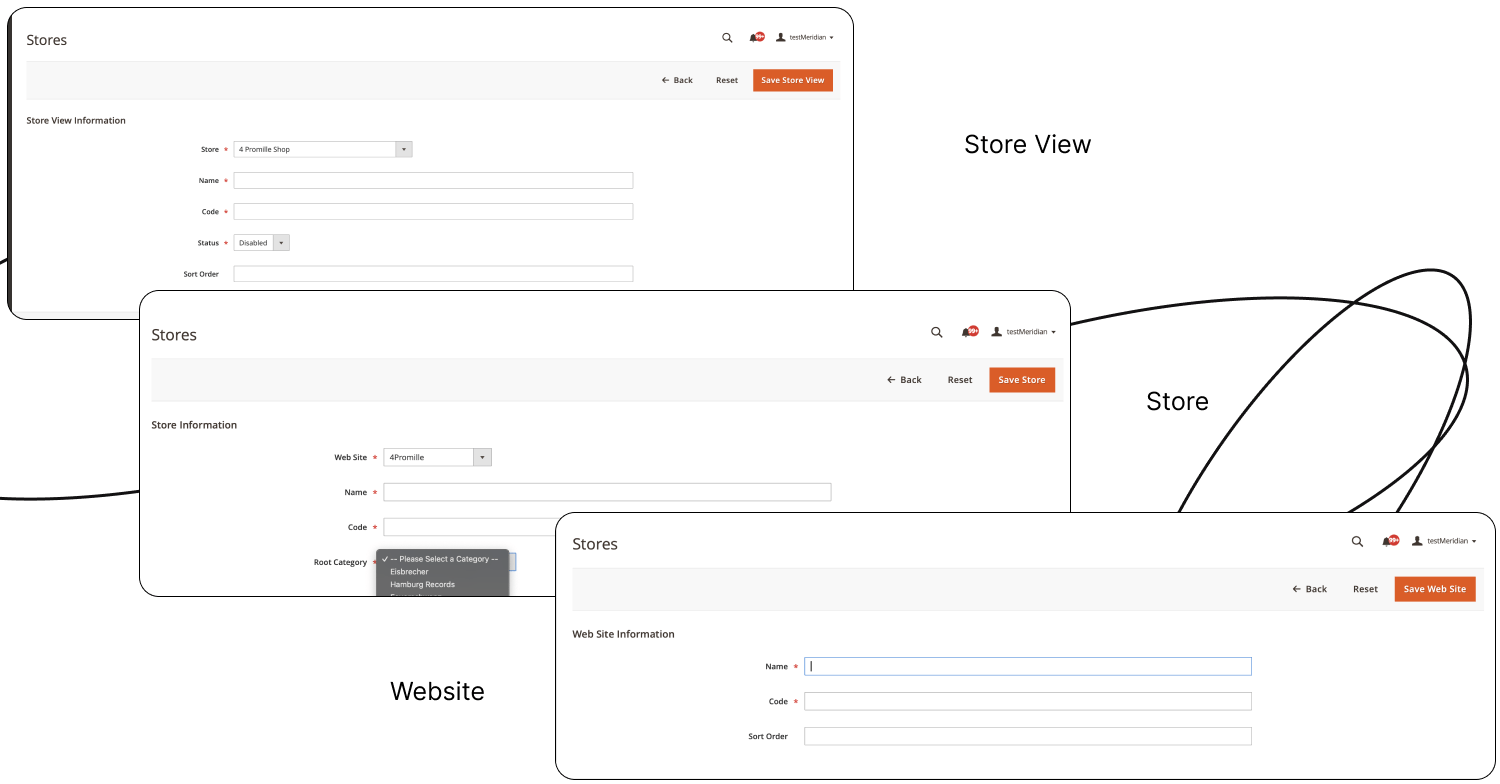
Step 3: Configure Store URLs
- Go to Stores -> Settings -> Configuration -> General -> Web.
- Select the Store View:
- Choose the specific store view you want to configure.
- Set the URL for each store view.
- Decide whether to add the store code to the URL or not.
Tip: Properly configuring your URLs helps with SEO and user navigation.
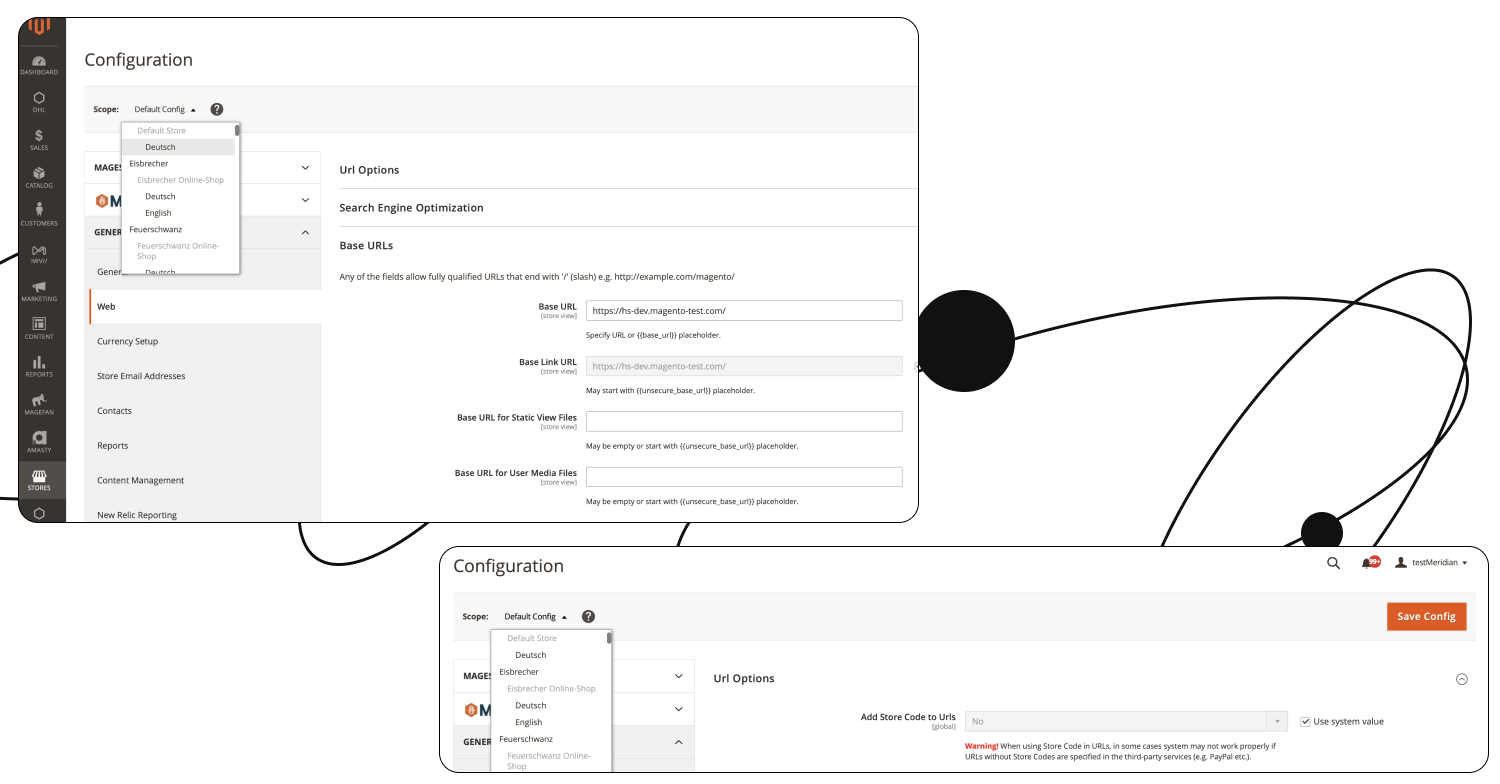
Step 4: Server Configuration
- Configure Your Server for Multistore:
- You’ll need to set up your server for each website URL.
Example Configuration:
<VirtualHost *:80>
ServerName german.mysite.ge
DocumentRoot /var/www/html/magento2/pub/
SetEnv MAGE_RUN_CODE "german"
SetEnv MAGE_RUN_TYPE "website"
</VirtualHost>
Tip: Not all hosting services are compatible with this setup, so it’s best to leave this to professionals.
Step 5: Theme Configuration
- Create and Configure Themes:
- Go to Content -> Themes to see all available themes.
- Check the parent theme for your custom theme.
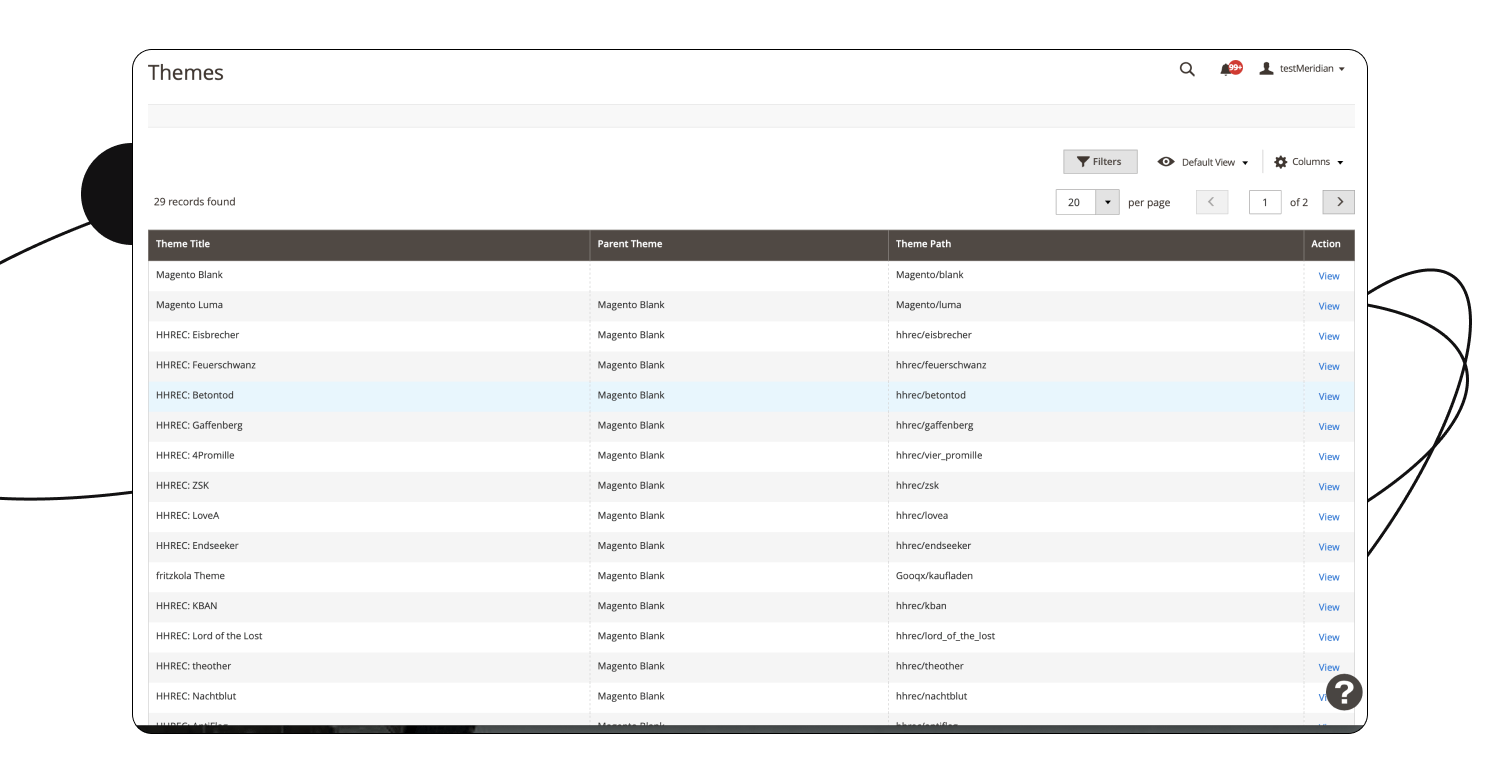
- Apply Themes to Stores:
-
- Go to Content -> Design -> Configuration.
- Select the theme for each store and modify information, add styles, head scripts, etc.
-
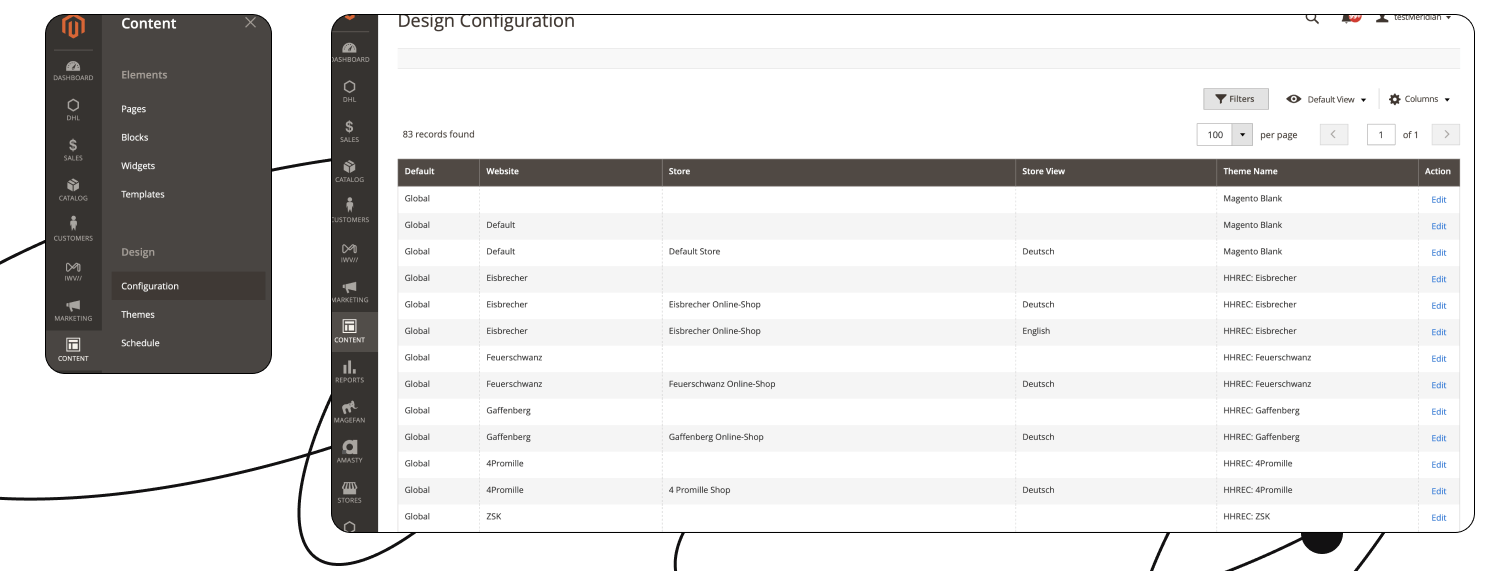
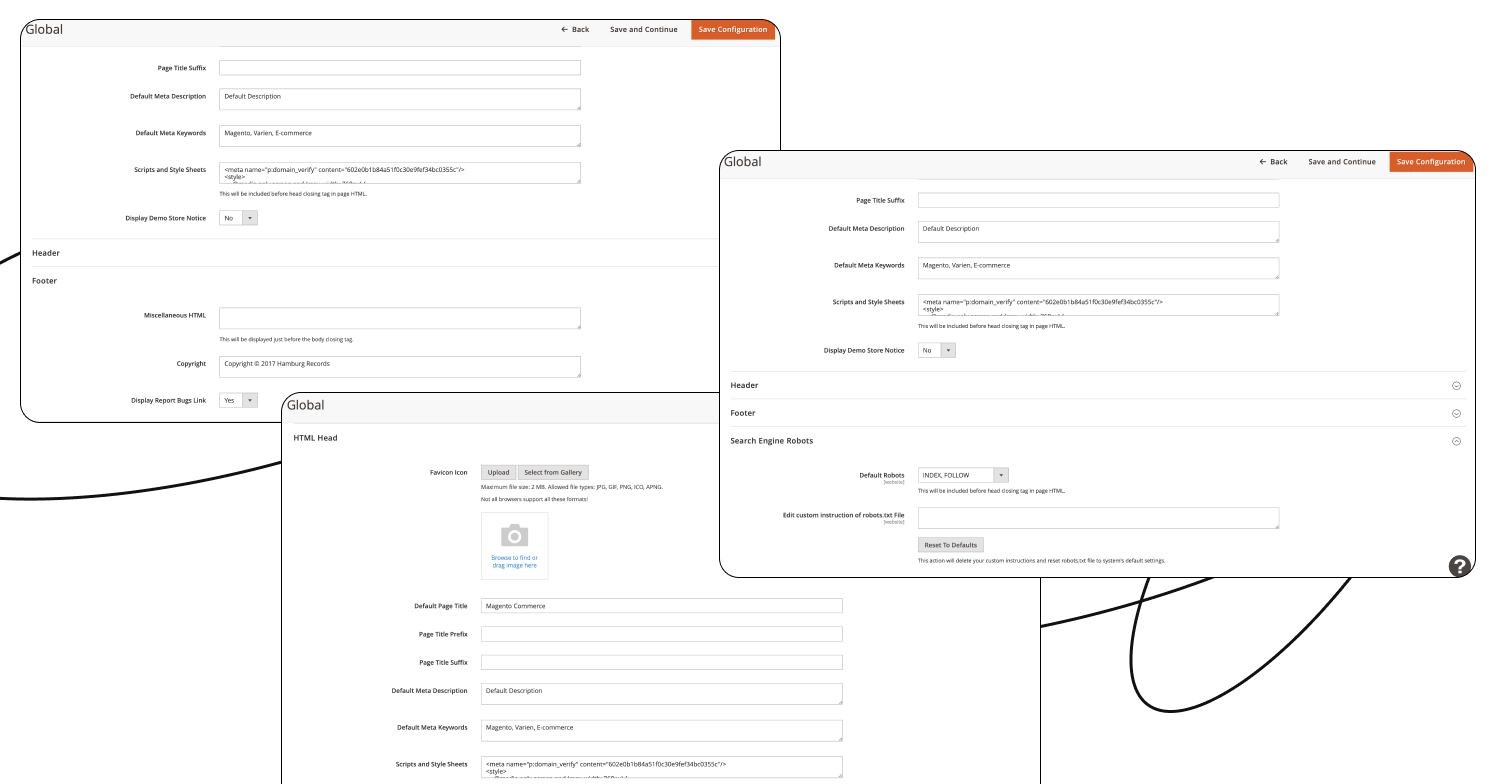
Step 6: Add Products
- Add and Modify Products at the Store Level:
- Navigate to Catalog -> Products.
- Add products and set specific attributes like name, price, URL key, meta-data, etc. for each store.
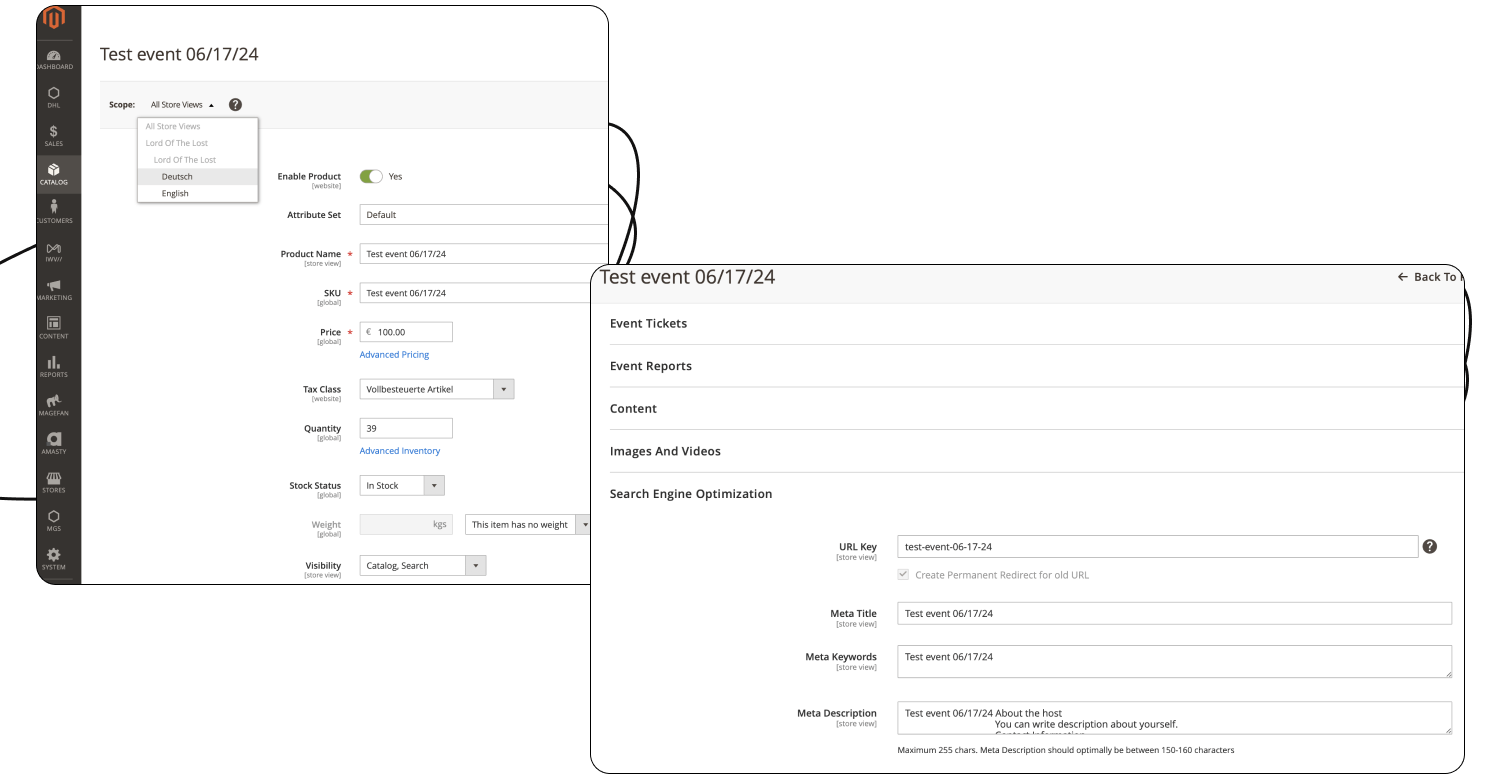
Get an eCommerce Expert Consultation
Our Adobe Business Practitioner will audit and optimize your site for robust performance.

Step 7: Configure Taxes
- Set Different Tax Rates and Rules:
- Go to Stores -> Taxes -> Tax Zones and Rates.
- Create different tax rates for each country and region.
- Then go to Stores -> Taxes -> Tax Rules to add needed settings and priorities.
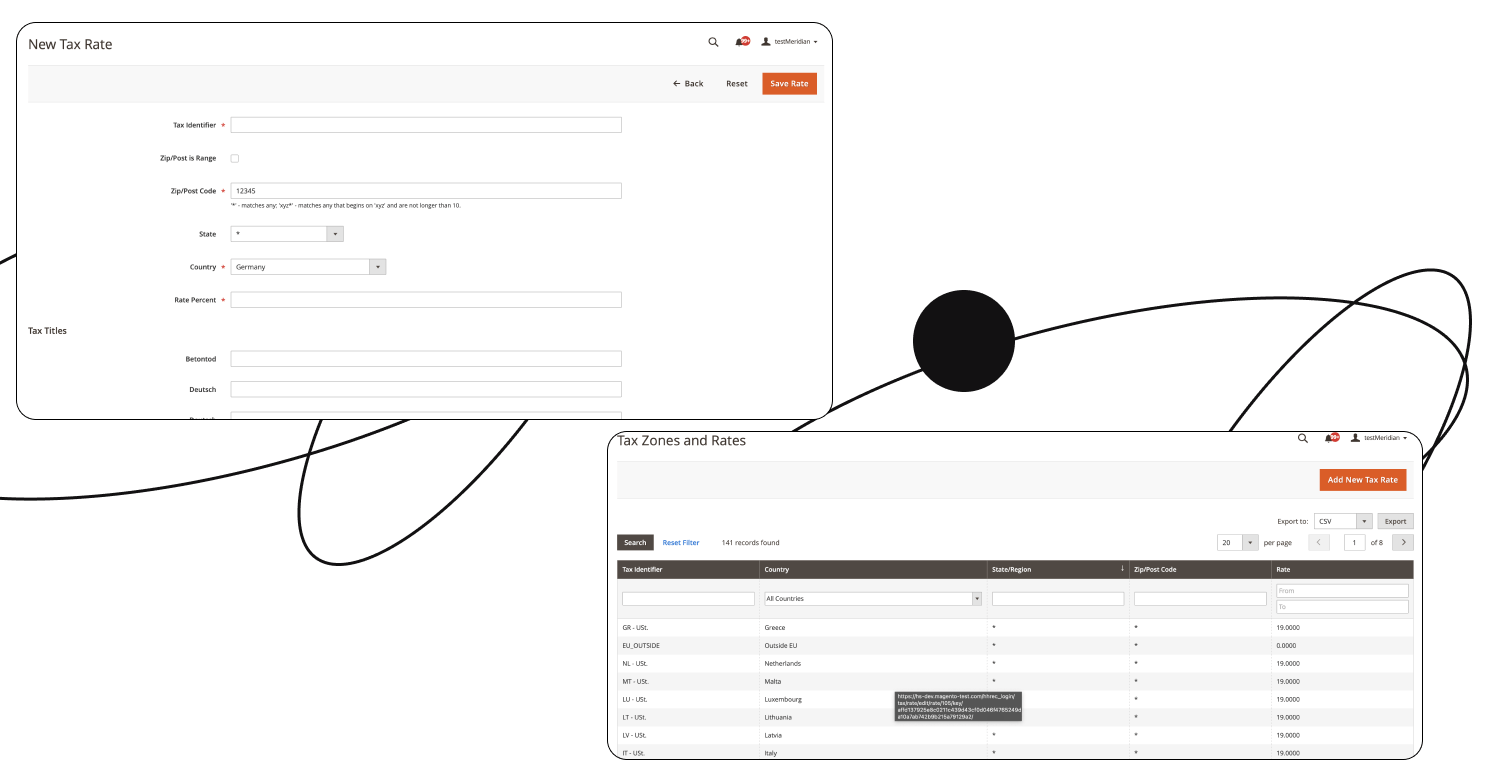
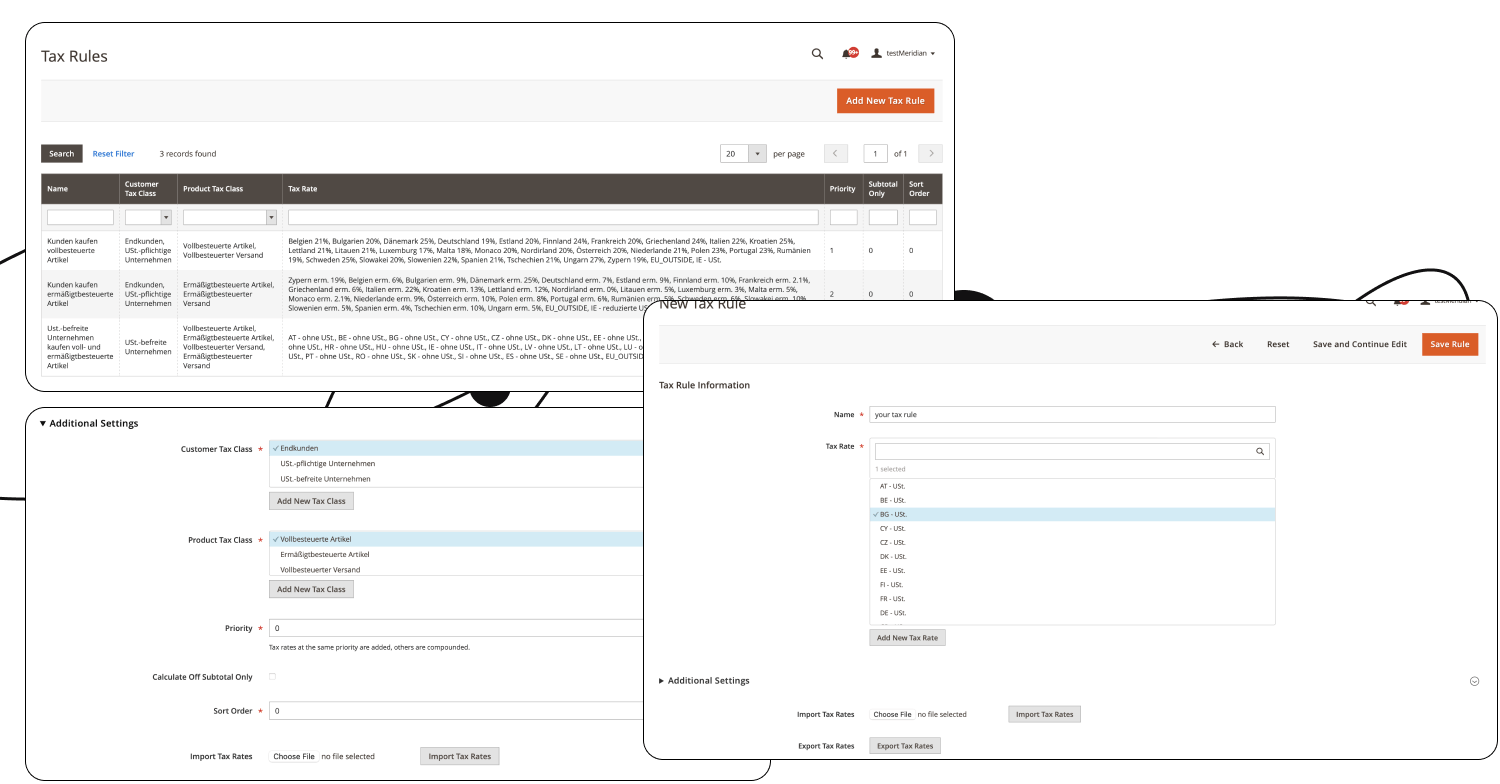
Step 8: Payment Methods
- Set Up Payment Methods:
- Navigate to Stores -> Configuration -> Sales -> Payment Methods.
- Remember, different payment methods require a separate website setup.
- At the store level, you can only enable/disable payment methods but not use different accounts.
Tip: Be careful with global, website, and store-level settings.
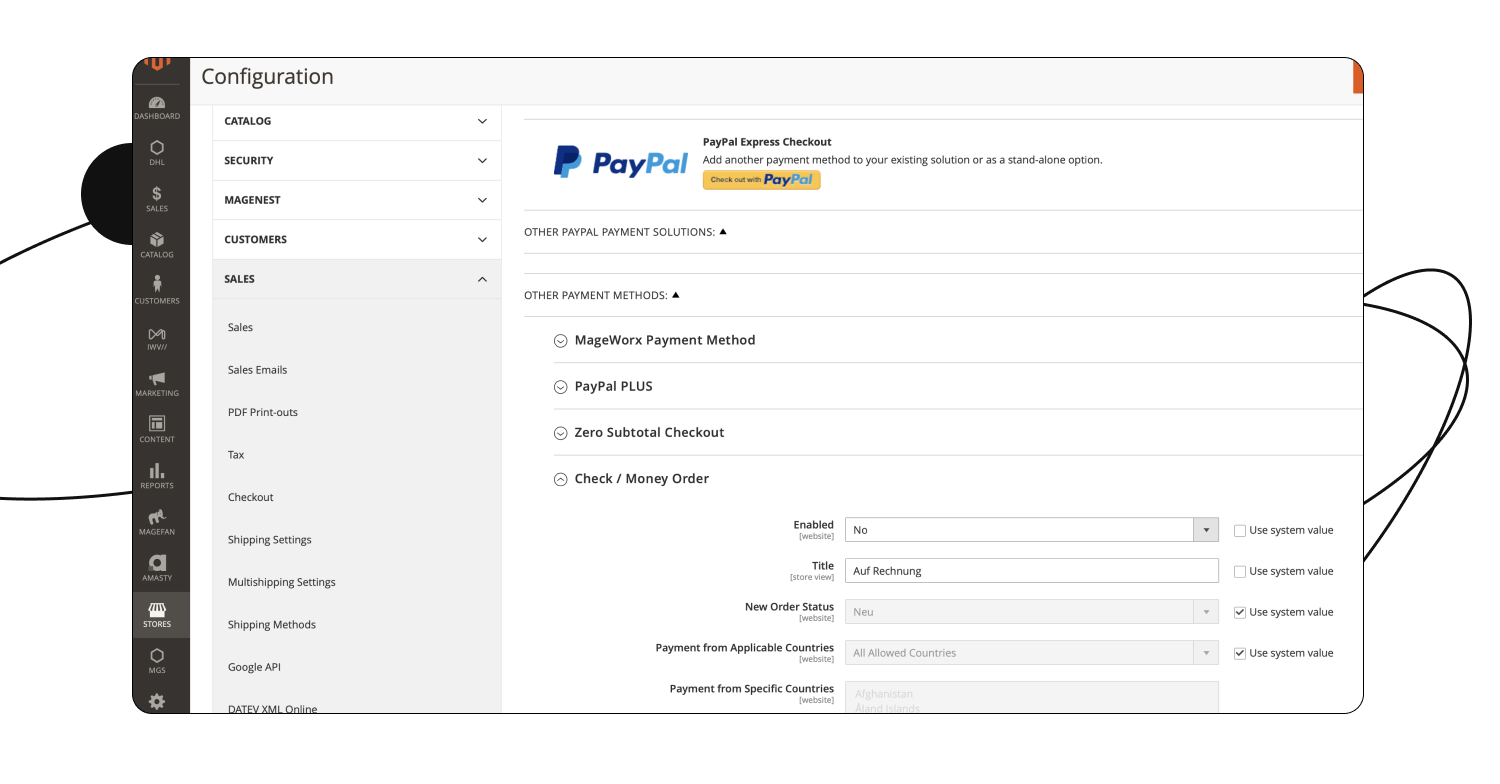
Step 9: Shipping Methods
- Configure Shipping Methods:
- Go to Stores -> Configuration -> Sales -> Shipping.
- Set your store address first.
- Enable/disable shipping methods and configure shipping rates at the website level.
Tip: Be cautious with setting levels – some settings apply globally, others at the website or store level.
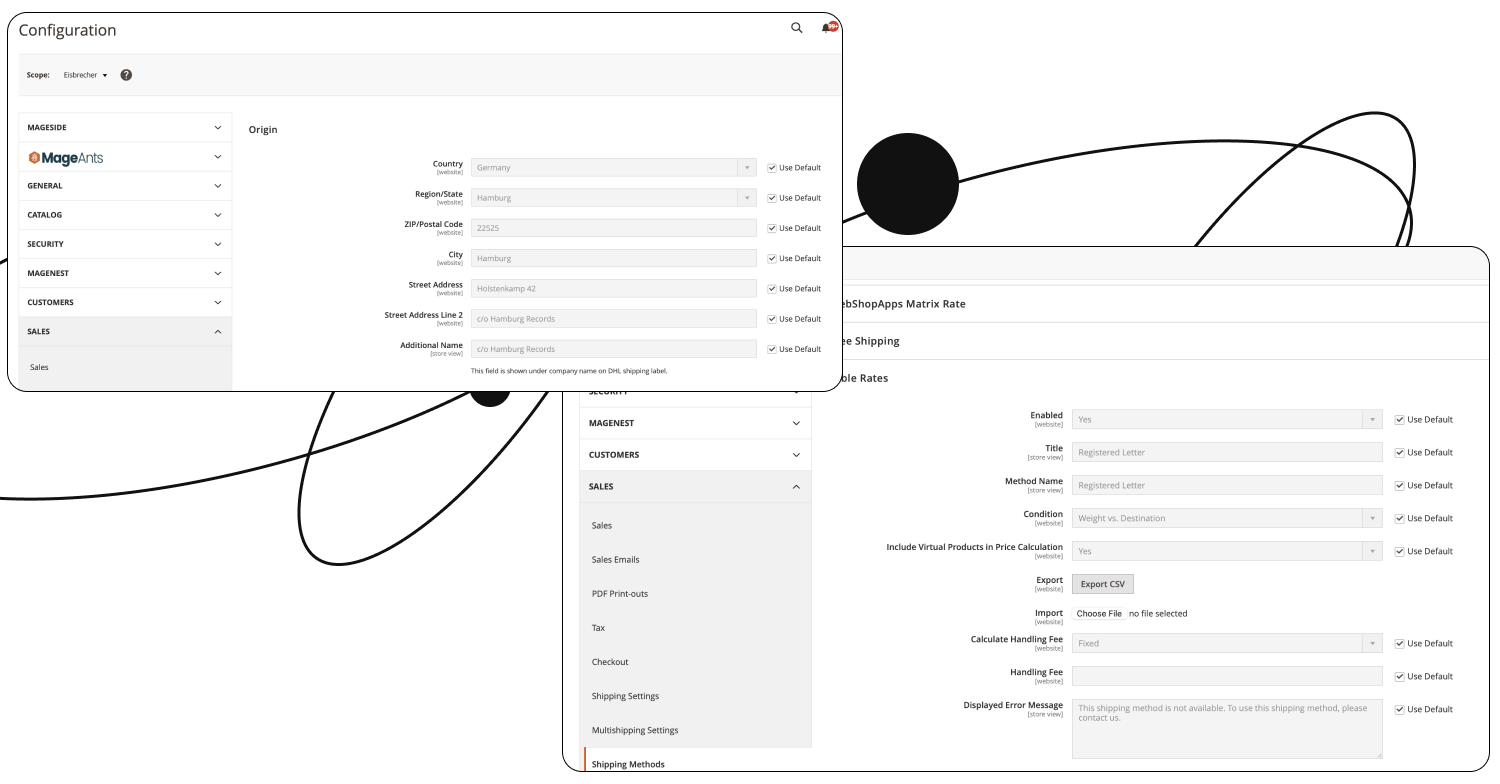
Step 10: Clear Cache
- Clear Cache Regularly:
- Navigate to System -> Tools -> Cache Management.
- Click Flush Cache to ensure all changes are applied.
Following these steps, you can set up a Magento multistore efficiently and effectively, optimizing each store to meet your business needs.
Magento Multi Store Development: Top 7 Questions and Answers from an Expert
In this Q&A session, we consulted with Pablo Poberezhnyi, an Adobe Certified Professional and Magento 2 developer with over 8 years of software development experience.
-
What steps involve customizing themes for different stores within the same Magento installation?
The process remains consistent, regardless of the number of stores. While you’ll have more themes to manage, the customization steps are the same as for a single store.
-
How do you configure tax settings for different regions in a Magento Multi Store setup?
Magento allows you to set different tax rates for various countries and regions. You can also create specific tax rules and priorities for these rates and determine the taxability of each product.
-
Can you explain how to set up and manage store-specific configurations, such as shipping methods and payment gateways?
For different payment methods, you need separate websites, as store-level configurations don’t support different payment accounts. Shipping methods can only be enabled or disabled at the website level, with store-level adjustments limited to titles and messages.
-
How do you optimize SEO for each store in a Magento Multi Store configuration?
SEO settings, including metadata like titles, keywords, and descriptions, can be managed at the store level for products, categories, and CMS pages.
-
What tools or extensions do you recommend for enhancing the functionality of the Magento Multi Store?
The choice of tools or extensions depends on specific requirements, but several robust options are available to improve various aspects of functionality.
-
How do you handle Magento Multi Store configuration updates and maintenance?
The update and maintenance process remains fundamentally the same, though managing multiple stores means more files to check and more functionality to test, increasing the time required.
- How do you handle different currencies and languages across multiple stores?
To handle different currencies and languages across multiple stores in Magento, follow these easy steps:
Set Up Currencies:
- Go to Stores -> Settings -> Configuration -> General -> Currency Setup.
Choose the base (default) currency for your store.
Select the list of available currencies by holding the Ctrl key while choosing the options.
Set Up Languages:
- Go to Stores -> Settings -> Configuration -> General.
Choose the Locale for your store to set the language.
You will also need translation files for the chosen language. For this step, it’s best to contact your developer to ensure everything is set up correctly.
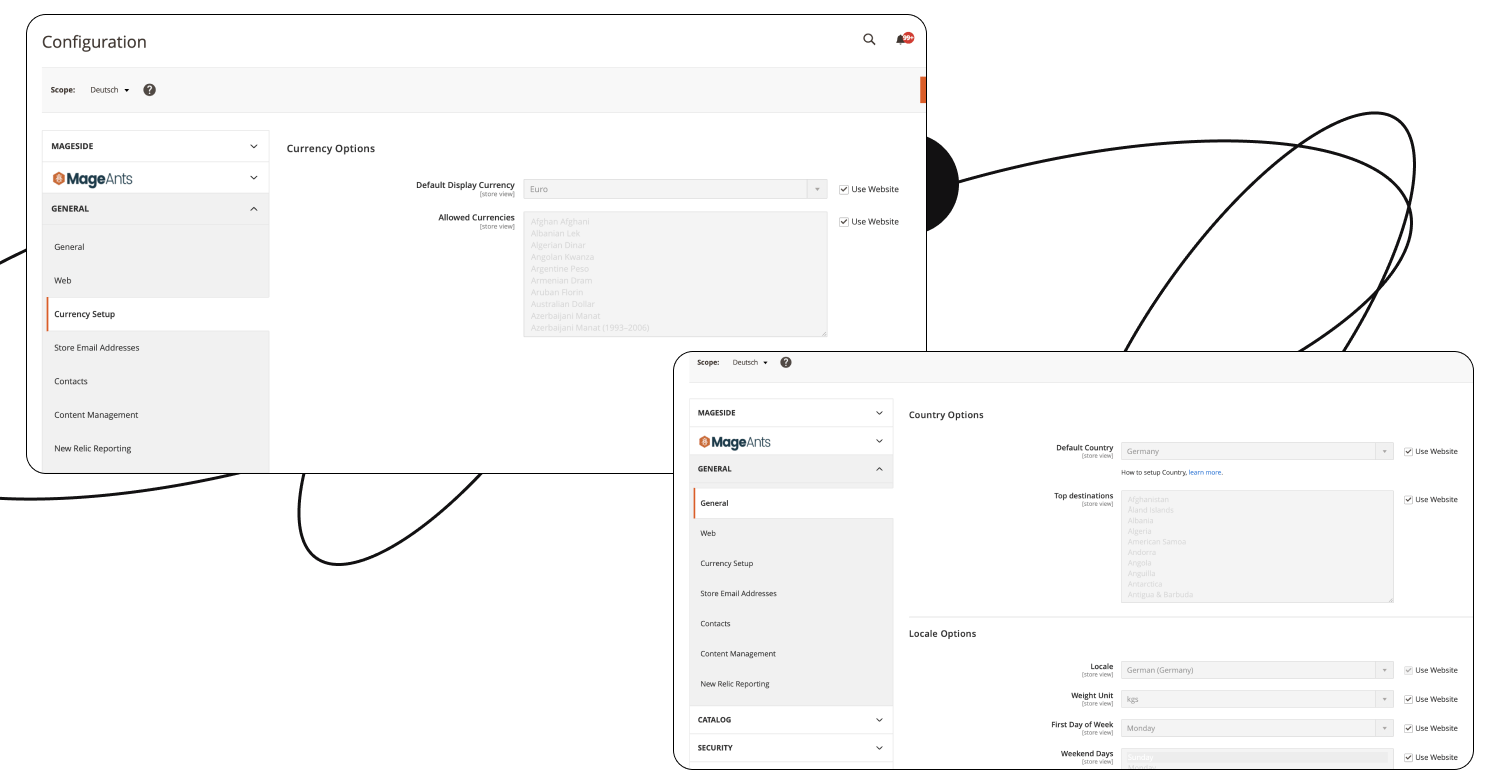
Say Goodbye To Site Crashes With eCommerce Website Audit
Don't let low site speed, lower conversion rates, and lost customers hold you back.

Understanding Magento Multi Store
With Magento 2, users can create as many stores for their site as they need. Let’s explore the Magento multi store setup, its benefits, and usage examples.
Definition and explanation of Magento Multistore
Magento Multi-Store feature enables businesses to operate many storefronts from a unified installation. It empowers users to construct and run numerous online stores with their distinguished style, product lines, price ranges, and even domains, which share a general administrative panel. The crucial features of Magento multiple stores comprise:
- Central Admin Panel: Merchants can operate all their stores from a central administrative panel.
- Shared Consumer Data: User accounts and data are common for all stores, granting a consistent experience.
- Independent Store Views: Store views, a subset of the store level, can be utilized in every store. Thus, every store can have its individual appearance, language, and product offerings.
- Centralized Management: Multi store in Magento 2 enables the central management of inventory, order processing, and other crucial functions.
Benefits of using Magento Multi-Store
Magento Multi Store is a valuable feature for businesses that work with multiple brands, product assortments, or websites under one corporate umbrella. It simplifies management tasks and streamlines customer data administration.
Specifically, the benefits include:
- Handling all products through one admin panel allows users to expedite and ease management tasks.
- Enhancing consumer data management.
- Simplifying the procedure of incorporating attributes and options like check-in, checkout, and add to cart.
- Enjoying the common shopping cart for multiple store views.
Examples of when to choose Magento Multi-Store
Overall, Magento 2 multi store is perfect for merchants selling in specific countries or having numerous brands to operate.
Magento multiple store will suit organizations with the following goals:
- Running numerous sites under an umbrella domain;
- Having no necessity to establish varying prices and payment and delivery opportunities for each store;
- Targeting the same client community.
The remarkable Magento multi store examples include:
- Rebecca Minkoff: Fashion brand Rebecca Minkoff utilizes Magento multi store to run an array of stores in one website. They keep a store for men, women, and accessories, allowing for a diverse product assortment while expediting backend processes.
- Nestle: Nestle, with its extensive portfolio of brands, Nestle employs Magento multi store to host individual brand websites. Brands like Nescafe, Nestea, and Gerber have their particular online space with distinct content, goods, and style, yet they are united by a single backend.
No More Lost Customers!
We offer tech audit and implementing of new theme with a hot feature set to rekindle customer interest and drive additional sales.

Exploring Magento Multi-Website
Magento multisite feature empowers you to oversee Magento stores, aiding you in adjusting payment methods, currencies, shipping, and other settings to work in any location.
Definition and explanation of Magento Multi-Website
Magento 2 multiple websites allow organizations to craft and operate an array of sites from a unified Magento installation. Each site performs independently with its particular domain and can have separate consumer communities, product catalogs, and configurations.
Primary features of Magento multi-website include:
- Separate domains: The opportunity to use an individual domain or subdomain for every site.
- Isolated data: Customer data, product catalogs, pricing, and configurations are separated among websites, guaranteeing the information independence.
- Autonomous stores: Each site can span various stores, which, in turn, can have store views, languages, and themes.
- Independent checkouts: Shoppers can purchase on one site without interacting with other sites.
- Distinct SEO strategies: Merchants can set up each site for search engines independently.
Advantages of using Magento Multi-Website
A multi-website opportunity grants merchants greater flexibility and comfort in controlling stores through a unified admin dashboard.
- Seamless data sharing through sites;
- The opportunity to customize every facet of the consumer experience;
- Target different client groups with each site;
- Hold separate inventories and shopping carts among websites;
- Apply independent SEO strategies.
Use cases for Magento Multi-Website
Companies should consider choosing Magento multi-website when they seek to establish:
- Distinct brands or businesses;
- Localized regional presence;
- Autonomous online stores;
- Separated business units;
- Various product categories.
Here are a few outstanding use cases of Magento multi-website:
- Land Rover: The brand leverages Magento multi-website to control its global online activities. Each region has a dedicated site with its domain and targeted content. Thus, Land Rover delivers localized information, pricing, and services while maintaining a consistent brand identity.
- Coca-Cola: The Coca-Cola portfolio comprises numerous brands, and each has its specific website. For instance, the Coca-Cola brand has its website, and so does Diet Coke. Each shares individual content, products, and experiences while providing common e-commerce functionalities.
Factors to Consider When Choosing Between Multi-Store and Multi-Website
Creating Magento 2 multi-stores or multi-websites is not very complicated. You need to examine the instructions and choose the right feature that aligns with your business’s growth plans. When making up your mind about the Magento multi store vs multi website, focus on the following primary factors.
Scalability and future growth
- Multi-Store: Generally, a Magento 2 multi store setup enables greater scalability for businesses wishing to manage numerous stores under a single umbrella website. This approach would be appropriate when your growth involves expanding product lines or categories within your existing website.
- Multi-Website: Multi-website would be a better choice when your growth plan encompasses entirely separate businesses, brands, or target markets. It allows for crafting autonomous and configurable websites.
Administrative complexity
- Multi-Store: Magento 2 multi store allows for minimizing user administrative efforts as all stores share a unified admin panel. Therefore, administrative work is becoming less complicated, streamlining overall store management.
- Multi-Website: Multi-website, however, can be more administratively complex because the feature unites a range of sites that run independently. Therefore, each website requires separate configurations, product catalogs, and consumer data administration.
Target audience and market segmentation
- Multi-Store: Magento multi stores are ideal when you wish to segment your target community or product lines within a unified website. It allows you to address diverse consumer groups while supporting a cohesive online presence.
- Multi-Website: Multi-website would accommodate the needs of organizations with entirely separate target audiences or businesses. This approach delivers greater flexibility if you wish to craft distinct identities for diverse markets or consumer bases.
SEO and branding requirements
- Multi-Store: With Magento 2 multistore, you can enjoy common SEO benefits throughout your stores since they belong to one domain. Therefore, each store would contribute to your overall SEO success and boost your website’s authority. Furthermore, it would ease the task of maintaining consistent branding across stores.
- Multi-Website: A multi-website approach empowers specified SEO strategies for each website, allowing you to tailor keywords, content, and optimization methods for specific target groups and regions. This will come in handy if you have vastly different SEO requirements. Aside from that, you’ll have the opportunity to perform individual branding elements on sites along with your requirements.
Cost considerations
- Multi-Store: Typically, Magento 2 multiple stores are more cost-effective since this approach eliminates the need for individual setups for each store. Therefore, it’s efficient for businesses with limited resources.
- Multi-Website: This option can be more costly due to the need for distinguished configurations and potentially distinct domains. It would be appropriate for businesses willing to build separate online identities.
Top 3 Disadvantages of Magento Multi Store
- Increased Complexity and Maintenance Requirements: Managing a Magento multi-store setup requires professional maintenance due to its increased complexity compared to a single store. Each store or website demands more resources and careful handling, even on the same Magento installation. This necessitates regular updates, thorough testing, and skilled management to ensure everything runs smoothly.
- Higher Resource Consumption: Operating multiple stores within a single Magento installation can lead to higher server resource consumption. You’ll likely need more robust hosting solutions to maintain optimal performance. The increased load on the server can result in slower site speeds if not properly managed, which can impact user experience and SEO rankings.
- Complicated Configuration and Customization: Customizing themes, configuring tax settings, and managing store-specific settings like payment gateways and shipping methods can be more complex in a multi-store environment. Each store might require unique configurations and customizations, adding to the workload and necessitating a deeper understanding of Magento’s architecture. This complexity can make initial setup and ongoing adjustments more time-consuming and potentially costly.
Best Practices and Implementation Tips
How to set up a Magento multi store and multi website? Based on our experience, we’ve compiled a list of primary recommendations for merchants who plan to follow either of these paths.
Best practices for setting up a Magento Multi-Store
The creation of Magento 2 multi-stores involves several essential steps:
1. Meticulous planning
Determine your objectives, whether it’s managing an array of brands, target markets, or product lines. Clearly outline your business’s structure and how you wish to represent it online.
2. Reliable hosting
Select a trustworthy hosting provider with adequate resources to support multiple stores. Consider dedicated hosting for optimal operation.
3. Domain configuration
Carefully configure domains for each store, ensuring that they are distinct and appropriately represent the individual stores or brands.
4. Unified database
Leverage a shared database to administer all stores. This simplifies data handling and guarantees access to consumer accounts and product information across stores.
5. Consistent design
Maintain a unified design and branding across all stores. Employ a common theme with tiny variations to introduce each store’s identity while supporting a coherent overall appearance.
6. Shared checkout and payment opportunities
Empower consumers from different shops to buy from a single cart. Furthermore, share payment opportunities throughout stores, yet you may grant each store specific payment options if necessary. Each store’s payment configuration must align with its region and buyer community.
7. Multi-currency and pricing
Remember that each store can operate its individual currency and pricing, catering to regional differences. Therefore, you should configure multi-currency support and pricing rules.
8. Powerful SEO strategy
Craft a comprehensive SEO strategy for each store or brand, optimizing content, keywords, and meta information to accommodate specific consumer groups and elevate visibility.
9. Security practices
Implement robust security techniques to guard consumer data and transactions. Maintain the non-compromised safety of consumer data sharing throughout stores.
10. Consumer support
Pamper users with multifaceted customer support to address their inquiries from different stores swiftly.
By implementing these tips, you can successfully set up and operate a Magento multiple stores environment encompassing diverse brands, goods, and consumer communities while supporting a consistent online presence.
Unleash Store Management Power
We'll create a simple admin for you to process orders quickly and open new doors for marketing and sales.

Best practices for configuring a Magento Multi-Website
Appropriately established multi websites in Magento can bring your business to the next level. Consider the following best practices to take full advantage of it.
1. Clear objectives and segmentation
Identify the objectives for each website contributing to your setup. Segment sites based on distinct brands, product lines, or target markets.
2. Unique domains
Benefit from the opportunity to establish unique domains for each website. Compose the domain names that reflect the individual website’s identity.
3. Individual configuration
Since your setup enables individual configuration, it makes sense to squeeze maximum use from it. Configure each site with distinct settings, including design themes, product catalogs, payment options, and delivery methods. Tailor configurations to match the specific needs of each website.
4. Independent store views
Take advantage of the subsequent Magento hierarchy level: create Magento 2 multiple store views for different languages or regional customization within each website. Craft tailored content and language preferences for diverse client communities.
5. Shared resources
Decide on which data is appropriate to share across websites, for instance, consumer information and product attributes. This makes data administration straightforward and ensures that consumers can navigate among websites smoothly.
6. SEO optimization
Develop an individual SEO strategy for each website, including keywords, meta tags, and content optimization tailored according to your target segment and region. Besides, implement URL rewrites and redirects to make each website’s content accessible through its respective domain or subdomain. This facilitates SEO and user journey.
7. Centralized management
Operate all websites through a centralized admin panel. Thus, you’ll ease controlling operations, tracking orders, and handling customer queries from every location.
Conclusion
Magento is a comprehensive platform that can amplify your business in various ways. Understanding its hierarchy and the capacity of each level will help you pave your way to a winning Magento store setup.
Choosing between multi-website and multi-store in Magento involves analyzing your specific business needs and assessing your long-term goals. Consider the fundamental factors, best practices, and use examples that we collected in this article.
However, the selection and implementation processes are intricate, and it’s better to get the support of professional Magento developers with expertise in this domain. WebMeridian has been establishing successful Magento sites for more than seven years. We can consult you on your project goals, help select the Magento setup aligning with your business model, and smoothly implement it for superior performance.
Contact us to discuss how you can configure your store and explore the new profitable opportunities for your business.
A multi-store in Magento is a feature empowering businesses to administer numerous online stores from a unified Magento installation. Each store can have an individual product catalog, style, pricing, and even domain. However, they share a unified administrative panel, customer data, and core functionalities. The feature comes on hand for businesses with an array of brands, product lines, or localized offerings that wish to maintain a cohesive online presence while accommodating diverse target groups.
The primary difference between a multi-store and multi-website in Magento is the degree of independence. In a multi-store setup, numerous stores share a single installation, administrative panel, and consumer information. They can operate distinct product catalogs and styles. In contrast, multi-website enables businesses to craft independent sites with their own domains and separate client data, configurations, and product catalogs. Multi-website delivers greater autonomy but is administratively more complex, whereas multi-store eases control but grants less independence.
Create a new shop view in Magento 2 by following these steps: #1. Click Stores on the Admin panel. Select All Stores in the Settings section. #2. Make the following changes after clicking the Create Store View button: Select the parent store of this view in the Store box. #3. Click Save Store View when you're finished.




